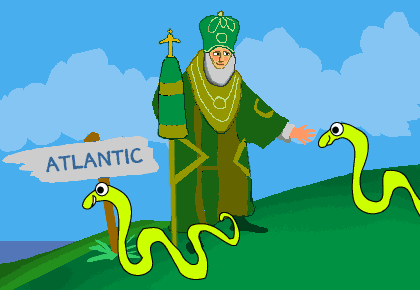|
I've long been pretty snobbish about all the hokie things associated with St. Patrick's Day, but I like these observations made by Larry Kirwan, the Irish-born leader of the band Black 47.
On one day a year, they congregated outside St. Patrick's Cathedral off Prince Street in New York City and marched in celebration. To some of these immigrant Irish and their American born children it was a religious occasion, but to most the gathering was an affirmation of their right, not only to survive but, to thrive in their adopted country. That's what I sense on St. Patrick's Day - an echo from a time when the Irish were despised outsiders. And that's why I go along with the raucous energy, the excitement and even the green beer, the plastic shamrocks and the ubiquitous leprechaun.
I didn't always feel that way. When I arrived from Ireland, these manifestations of Irish-America were at best embarrassing. Back home, our own celebrations were rigid and religious; we did sport actual sprigs of shamrock but there was no beer, green or otherwise. The Parade up Fifth Avenue and the ensuing bacchanal seemed downright pagan by comparison.
I had other immigrant battles of my own ahead. The band, Black 47, was formed to create music that would reflect the complexity of immigrant and contemporary Irish-American life and to banish When Irish Eyes Are Smiling off to a well earned rest in the depths of Galway Bay. This idea met with not a little resistance in the north Bronx and the south sides of Boston and Chicago; but when irate patrons would yell out in the middle of a reggae/reel "why can't yez sing somethin' Irish?" I would return the compliment with, "I'm from Ireland, I wrote it! That makes it Irish!"
With time and familiarity, Irish-America came to accept and even treasure Black 47, probably more for our insistence that each generation bears responsibility for solving the political problems in the North of Ireland, than for recasting Danny Boy as a formidable gay construction worker. I, in turn, learned to appreciate the traditions of the community I had joined along with the reasons for the ritualized celebration of our patron saint. And now on St. Patrick's Day, no matter what stage I'm on, mixed in with the swirl of guitars, horns, pipes and drums, I hear an old, but jarring, memory of a people rejoicing as they rose up from their knees.
All our battles, for the most part, have been won; indeed, one has to search an encyclopedia for mention of the Know-Nothing Party or various 19th Century nativist politicians and gangs. Anti-Irish sentiment, not to mention Anti-Catholicism is a thing of the past. Might it not be time then that our New York St. Patrick's Day Parade broaden its parameters to celebrate all Irishness no matter what religion (or lack thereof), sexuality or political conviction. It's a broad step, I know. But now with the makings of a just peace finally taking seed in the North of Ireland, might we not some day witness Dr. Paisley, Mr. Adams and various members of the Irish Gay community walk arm in arm up Fifth Avenue. Impossible? Perhaps, but I, for one, would have wagered heavily 15 years ago that the Sinn Fein party would never sit in a Northern Irish Parliament. Times change and with them tactics and, even, treasured principles.
Whatever about Parade pipe dreams, we still must honor the memory of those who paved the way for us. Part of that responsibility is that Irish-Americans should never forget the new immigrants from other lands, legal and otherwise. Many, like our forebears, are fleeing tyranny, economic and politcal, and are striving to feed and educate their families. It would be the ultimate irony if an Irish-American were to look down upon the least of them; for, in my mind anyway, there is no place in the Irish soul for racism, sectarianism, homophobia or even dumb old Archie Bunker type xenophobia.
I once heard Pete Hamill, the writer, ask: "What does the Pakistani taxi driver say to his children when he gets home after 12 hours behind the wheel?" I can't say for certain but I'll bet he echoes many of the sentiments of those Irish who gathered outside St. Patrick's Cathedral so many immigrant tears and years ago.
Have a great day,
Larry Kirwan
|



